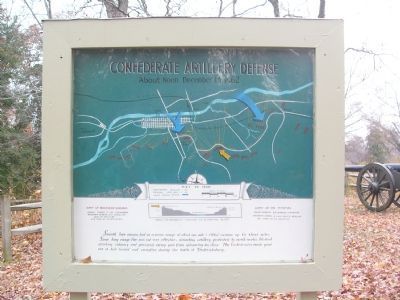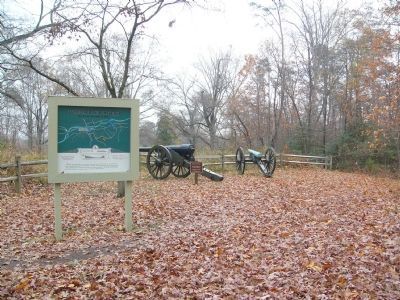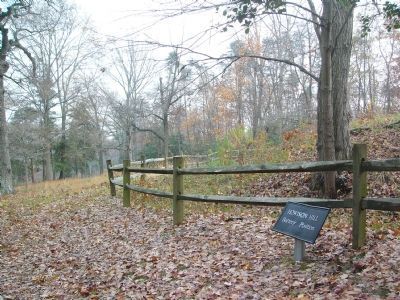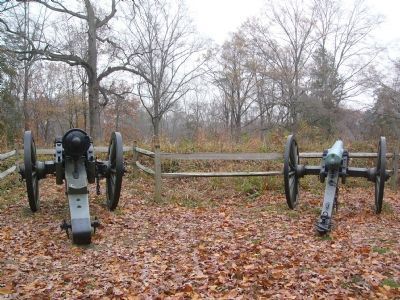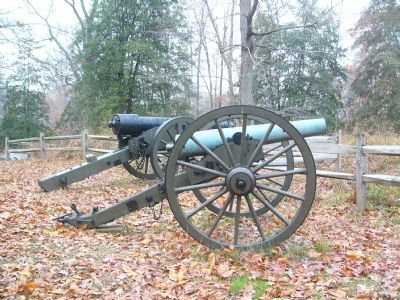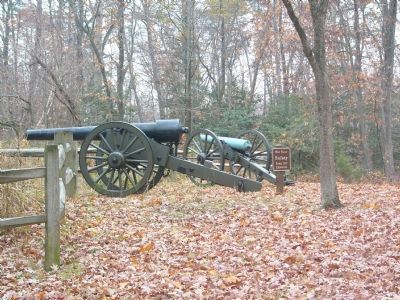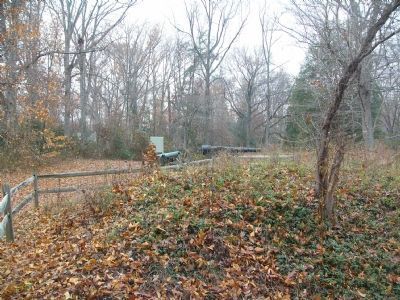Near Fredericksburg, Virginia — The American South (Mid-Atlantic)
Confederate Artillery Defense
About Noon December 13, 1862
General Robert E. Lee, Commander
Brigadier General W. N. Pendleton
Chief of Artillery
304 guns on the battlefield
Army of the Potomac
Major General A. E. Burnside, Commander
Brigadier General H. J. Hunt, Chief of Artillery
381 guns on the battlefield
Smooth bore cannon had an extreme range of about one mile; rifled cannon up to three miles. Since long range fire was not very effective, defending artillery, protected by earth-works, blasted attacking infantry and prevented enemy guns from advancing too close. The Confederates made good use of both frontal and crossfire during the Battle of Fredericksburg.
Topics. This historical marker is listed in this topic list: War, US Civil. A significant historical month for this entry is December 1866.
Location. 38° 16.71′ N, 77° 28.424′ W. Marker is near Fredericksburg, Virginia. Marker is on Lee Drive, on the right when traveling east. Marker is located along Lee Drive in the Fredericksburg-Spotyslvania Military Park, near a parking pullout. Touch for map. Marker is in this post office area: Fredericksburg VA 22401, United States of America. Touch for directions.
Other nearby markers. At least 8 other markers are within walking distance of this marker. Big Gun at Howison Hill (within shouting distance of this marker); Braehead (approx. 0.2 miles away); Lee’s Hill (approx. half a mile away); The Pioneers (approx. half a mile away); The Second Battle of Fredericksburg (approx. half a mile away); Artillery on Lee's Hill (approx. half a mile away); Lee's Hill, the commander's lookout (approx. half a mile away); Near Disaster (approx. half a mile away). Touch for a list and map of all markers in Fredericksburg.
Additional commentary.
1. Cannon Identification
The rifled cannon pictured here (black) is a 30pdr (4.2in) Army Parrott Rifle. The cannon fired a 9 to 11 inch long, 4.2 inch diameter shell weighing between 25 and 30 pounds (hence its designation). The weapon ranged to 6700 yards at a 25 degree elevation. As such, the weapon here at Howison Hill could fire upon Federal positions across the river in Stafford County. This particular weapon holds the registry number 323. It was produced in 1864 at West Point Foundry, New York (as were all Parrott cannon) and weighed 4,205 pounds at time of acceptance to service.
The bronze smoothbore (green-gray)is a Confederate 12-pdr Napoleon cannon made at Tredegar Iron Works, Richmond, Virginia. Little is known about this specific piece other than it was made in 1863. The Confederate Napoleons were generally copies of the Federal Model of 1857 of the same caliber, but typically had straight muzzles (Federal models have a swell or rounded portion near the muzzle). With less range than the Parrott rifle, the Napoleon was used to augment the fires of the larger weapon by covering the shorter ranged targets, such as advancing enemy infantry. It could fire projectiles to ranges between 1300 yards (explosive shells) and 1680 yards (solid shot).
— Submitted December 19, 2007, by Craig Swain of Leesburg, Virginia.
Credits. This page was last revised on February 2, 2023. It was originally submitted on December 11, 2007, by Kevin W. of Stafford, Virginia. This page has been viewed 1,640 times since then and 19 times this year. Photos: 1, 2, 3, 4, 5, 6, 7. submitted on December 11, 2007, by Kevin W. of Stafford, Virginia.
